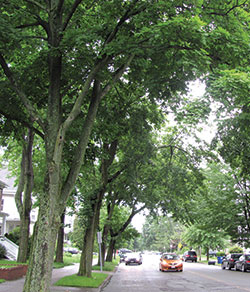
750 Healthy trees to receive ash borer prevention treatments; 150 sickly ash trees proposed for removal and replacement; Public hearing on proposed removals May 25th
With the potential for emerald ash borer infestation on the rise locally, the City of Somerville is taking preventive measures to stop the spread of the destructive pest to avoid potential tree loss. Efforts include preventive treatments for healthy ash trees and the proposed removal and replacement of sickly ash trees to avert subsequent widespread infestation.
Ash borers, small beetles native to Asia, are considered highly aggressive and can lead to tree death within one to three years of infestation. Since their arrival in the United States in 2002, they have caused the destruction of tens of millions of ash trees in 25 states. They were first detected in Massachusetts in the western town of Dalton in 2012. By 2014, ash borers were reported in Boston and in 2015 in Worcester. Ash trees within 10-15 miles of an ash borer infestation are considered at risk. Preventive measures including systemic treatment of healthy trees and removal of vulnerable trees can however reduce potential tree loss. The City of Somerville is using both approaches to protect the approximately 900 public ash trees in the City.
“We have just over 12,000 public trees in Somerville, and 900 of those trees—about 8 percent—are ash trees and we want to be sure to take advantage of every best practice to protect as many of these important and attractive shade trees,” said Mayor Joseph A. Curtatone. “We’ve been steadily building up our tree canopy in recent years with diverse tree varieties. To avoid widespread ravages from tree-specific diseases and pests like we saw with Dutch elm disease, we no longer use the traditional approach of planting the same trees all in a row. But many of our older trees are from limited varieties and we need to take targeted action to ensure they survive.”
Currently, roughly 750 of the city’s 900 ash trees are in good condition and these trees will be given preventive injections of TreeAzin®. Unfortunately, roughly 150 of the city’s ash trees are in poor or dying condition currently, and these trees need to be removed and replaced. Trees in poor condition are more susceptible to ash borer infestation and usually do not respond to preventive treatment. If vulnerable trees are allowed to become infested, they can provide a breeding ground from which the ash borer can spread to and overwhelm healthy ash trees.
To protect the City’s approximately 750 healthy ash trees, the City arborist has recommended that the 150 poor condition ash trees be removed and replaced with other species of trees that thrive well in street and sidewalk environments. Removal and replacement is a common best practice employed by many cities including nearby Cambridge. A public hearing will be held on the proposed removals/replacements in Somerville and all are welcome (see information below).
“It’s already tough for city trees to survive,” said DPW Superintendent of Highways, Lights and Lines Steve MacEachern. “Urban conditions stress trees with everything from car exhaust and paved surfaces to vandalism, road salt, dog waste and accidents. That’s what has taken its toll on our ash trees that are in poor condition, and usually we’d keep those trees going as long as we could. But with the ash borer potentially at our doorstep, we can’t risk all 900 trees on the hopes that the 150 sick ones will not be infested. Replacing them with healthy trees from a range of varieties will help us keep our streets and parks green.”
Public Hearing on Ash Borer Prevention Tree Removal/Replacement
As with all tree removals in Somerville, a public hearing on the proposed removals/replacements will be held. To see a list of all trees proposed for removal/replacement, please visit www.somervillema.gov/eab (scroll down). Written comment may be submitted to Steve MacEachern at smaceachern@somervillema.gov.
Public Tree Hearing
Wednesday, May 25, 5:30 p.m.
Somerville Water Department
17 Franey Road, Somerville (next to the DPW building)
~City of Somerville
















Reader Comments